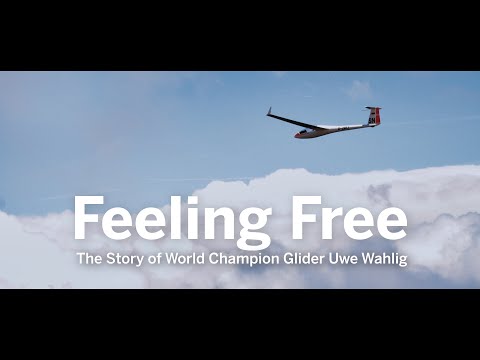The untrained eye can’t see it, but Uwe Wahlig’s competition glider is obsolete. Forty-plus years, three generations of wing profile refinements, and other design changes separate Wahlig’s plane from the latest gliders. But the reigning world gliding champion in the Club Class remains true to his trusty LS-3 sailplane built in 1977.
To be perfectly clear, as a senior developer at SAP, Wahlig doesn’t oppose technological advances. But when he sees value in something, he holds onto it and improves it. He applies this principle to many things in his life, but it’s perhaps most evident in his vintage glider. Together, Wahlig and his LS-3 “November Sierra” glider consistently finish ahead when competing against the best pilots and planes in the world.

Video by Natalie Hauck, Alexander Janusche, and Matteo Rogolino
If he weren’t so successful, the German pilot with long hair could conjure memories of Björn Borg’s attempted tennis comeback with a wooden racket against carbon in 1991. But Wahlig pulls it off without a trace of bravado. In June, he achieved an astonishing fourth place in the Racing Class competition at the German National Championships in Zwickau, Germany, also placing first on the fastest day of racing.
For Wahlig, the joy of flying is the ultimate goal. Pilots at the German nationals applauded his gliding mastery. Because, in addition to his flying skills, he is revered among the gliding community for his quiet nature, sportsmanship, and calmness under pressure.
Optimizing Everything
Wahlig’s calm demeanor belies a burning passion for the sport of competitive gliding and an unabating lifelong drive to optimize everything about himself and his plane. He leaves nothing to chance in preparing for competitions, meticulously studying the geography and climatic conditions wherever he flies. There is a myriad of variables in the course of a flight that a pilot needs to consider, and he knows them all. “You always keep an eye on the clouds and the ground to have an idea where the thermals come from, and you need to be optimizing everything during the competition,” Wahlig says.
His passion to optimize everything stems from his experiences building and flying model airplanes as a boy. What began with launching paper airplanes from the second story window of his grandmother’s house into the neighbor’s yard continued with the construction of his first model gliders of balsa wood. “My father wasn’t impressed with my initial models, but with time they got better and better,” he says today.
Soon, Wahlig was testing and refining his model planes with his friends at the local glider club in Bensheim, Germany. At 17 he earned his glider pilot rating and at 19 he already won his first national youth gliding competition. He was always finding new ways to improve his flying skills with the club’s planes, which at the time were made mostly of wood. All along his path to becoming world champion, he was intuitively applying “continuous improvement,” a widely recognized software development approach whereby incremental changes are made that add immediate value for end-users.
As a software engineer at SAP, Wahlig is detail-oriented and accustomed to applying the latest technology to test and optimize the operation of business software for hundreds of thousands of business customers worldwide. “I apply the same focus I have during gliding competitions to my work improving software solutions,” he says. By taking advantage of SAP’s flexible working policy, the glider pilot has been able to hone his skills and compete at competitions across Europe and beyond.
The Sky Is Not the Limit
Wahlig is constantly pushing the limits of himself and his LS-3. Improvements he has made to the plane’s flight characteristics and instrumentation have helped him achieve the maximum possible performance for the vintage glider. For example, he added winglets and installed bug wipers to reduce drag and maximize the gliding ratio, and he recently installed the latest instrumentation for navigating and locating the maximum lift in thermals. “A good plane and good pilot are important, but to reach the last two percent of performance, you need good instruments,” says Wahlig.
At the German nationals in Zwickau, Wahlig knew he wouldn’t stand much of a chance against modern gliders on days with very strong thermals. But competitions are conducted under varying weather conditions, so a day with weak thermals or changing conditions could benefit a lighter plane like his LS-3.
Several challenging flying days played into the gliding champion’s strategy, and by keeping a cool head and waiting for the best opportunities he was able to maintain consistently good results throughout. Flights can be up to five hours long in the same position – half sitting and half lying, so he practices yoga to relax between flights. “This brings you back to the ground when you are in the air so long,” Wahlig says. The added flexibility in his neck and shoulders also affords him a nearly 360-degree view from the cockpit.
“Preparation, consistency, and simply the avoidance of stupid mistakes are often more important than the plane you are flying,” he says. He’s convinced that recent competitions have helped him better understand the limits and strengths of his 45-year-old glider. “I have a lot of new ideas and have recently made a lot of improvements in the way I fly,” says Wahlig without mentioning any trade secrets.
Wahlig is now preparing for the next competitions to help him defend his No. 1 ranking at the 2023 World Gliding Championships in Australia. There, you can be sure that he will be flying his trusty LS-3 along the fastest route from thermal to thermal. Because for Wahlig, the sky is not the limit.



